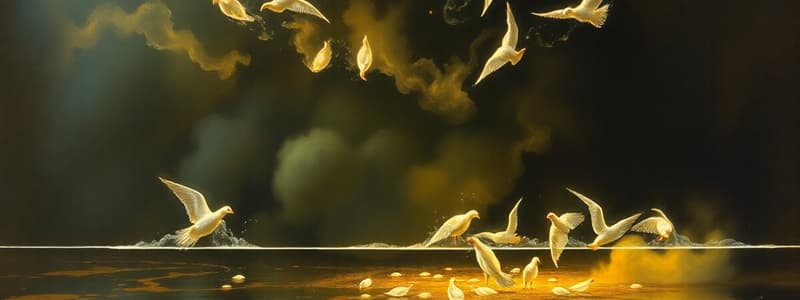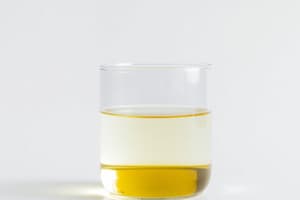Podcast
Questions and Answers
What is the vapor phase mole fraction of CO2 when x1 is 0.01 in carbonated water?
What is the vapor phase mole fraction of CO2 when x1 is 0.01 in carbonated water?
- 0.01227
- 0.9988 (correct)
- 0.0012
- 0.99
Henry's law applies only under high pressure conditions.
Henry's law applies only under high pressure conditions.
False (B)
What is the value of Henry's constant for CO2 in water at 100°C?
What is the value of Henry's constant for CO2 in water at 100°C?
990 bar
According to Raoult's law, the total pressure P can be expressed as P = x1H1 + x2P2sat, where x1 is the mole fraction of component 1 and P2sat = _____ at 100°C.
According to Raoult's law, the total pressure P can be expressed as P = x1H1 + x2P2sat, where x1 is the mole fraction of component 1 and P2sat = _____ at 100°C.
Match the following terms with their definitions:
Match the following terms with their definitions:
What point is referred to as the bubble point in a phase diagram?
What point is referred to as the bubble point in a phase diagram?
Raoult’s Law states that the liquid phase is an ideal solution only when species are chemically different.
Raoult’s Law states that the liquid phase is an ideal solution only when species are chemically different.
What is the definition of the dew point in a phase equilibrium context?
What is the definition of the dew point in a phase equilibrium context?
In a phase equilibrium diagram, the line connecting liquid and vapor compositions is called a _________.
In a phase equilibrium diagram, the line connecting liquid and vapor compositions is called a _________.
Which law is applicable to describe the behavior of ideal gases in vapor phase?
Which law is applicable to describe the behavior of ideal gases in vapor phase?
Henry’s Law is valid for solutions with chemically similar components only.
Henry’s Law is valid for solutions with chemically similar components only.
What assumption is made regarding the vapor phase in the context of Raoult’s Law?
What assumption is made regarding the vapor phase in the context of Raoult’s Law?
What is the main purpose of Raoult's Law in the context of phase calculations?
What is the main purpose of Raoult's Law in the context of phase calculations?
The bubble point calculation requires knowledge of the total pressure and the liquid phase mole fractions.
The bubble point calculation requires knowledge of the total pressure and the liquid phase mole fractions.
What is the Antoine equation used for in vapor pressure calculations?
What is the Antoine equation used for in vapor pressure calculations?
In a binary mixture, the sum of the mole fractions in the vapor phase must equal ______.
In a binary mixture, the sum of the mole fractions in the vapor phase must equal ______.
Match the calculations to their corresponding conditions:
Match the calculations to their corresponding conditions:
Which of the following statements about dew point calculations is FALSE?
Which of the following statements about dew point calculations is FALSE?
The vapor pressures of the pure species in a binary system always increase with temperature.
The vapor pressures of the pure species in a binary system always increase with temperature.
What is the definition of equilibrium in a thermodynamic context?
What is the definition of equilibrium in a thermodynamic context?
In the bubble point calculation, what do you calculate using the given liquid phase mole fractions and temperature?
In the bubble point calculation, what do you calculate using the given liquid phase mole fractions and temperature?
The Phase Rule states that all variables in a system can be independently fixed.
The Phase Rule states that all variables in a system can be independently fixed.
What is the formula to calculate the degrees of freedom (F) according to the Phase Rule?
What is the formula to calculate the degrees of freedom (F) according to the Phase Rule?
According to Duhem's theorem, a closed system is completely determined when any two independent ____________ are fixed.
According to Duhem's theorem, a closed system is completely determined when any two independent ____________ are fixed.
Match the following terms with their explanations:
Match the following terms with their explanations:
What is the maximum number of variables that must be specified to fix the intensive state of a system with two chemical species?
What is the maximum number of variables that must be specified to fix the intensive state of a system with two chemical species?
The total number of equations required for a completely determined state is given by πN.
The total number of equations required for a completely determined state is given by πN.
State the two independent variable types mentioned in Duhem's theorem.
State the two independent variable types mentioned in Duhem's theorem.
What is the saturated pressure P1 at 75°C according to the Antoine equation?
What is the saturated pressure P1 at 75°C according to the Antoine equation?
At a fixed pressure of 70 kPa, T1sat is greater than T2sat.
At a fixed pressure of 70 kPa, T1sat is greater than T2sat.
What equation is used to calculate the temperature T for species 1?
What equation is used to calculate the temperature T for species 1?
At a pressure of 70 kPa, the value of T2sat is _____ °C.
At a pressure of 70 kPa, the value of T2sat is _____ °C.
Match the following variables to their corresponding values:
Match the following variables to their corresponding values:
What is the relationship between x1 and y1 according to Raoult's law?
What is the relationship between x1 and y1 according to Raoult's law?
The value of α can be calculated using the difference between lnP2sat and lnP1sat.
The value of α can be calculated using the difference between lnP2sat and lnP1sat.
What is the value of P at x1 = 0.6, according to the provided calculation?
What is the value of P at x1 = 0.6, according to the provided calculation?
Flashcards
Henry's Law
Henry's Law
A relationship between the partial pressure of a gas above a liquid and the concentration of the gas dissolved in the liquid. It states that the partial pressure of a gas above a liquid is proportional to the mole fraction of the gas dissolved in the liquid. This means that higher gas pressure will result in a greater amount of gas dissolved in the liquid.
Henry's Constant (H)
Henry's Constant (H)
A constant that expresses the relationship between the partial pressure of a gas and its mole fraction in a liquid solution. It is specific to the gas and the liquid and can be used to calculate the solubility of the gas in the liquid.
Assumptions of Henry's Law
Assumptions of Henry's Law
It assumes that the gas phase behaves as an ideal gas and the liquid phase is treated as a very dilute solution.
Equilibrium
Equilibrium
Signup and view all the flashcards
Phase rule
Phase rule
Signup and view all the flashcards
Duhem's Theorem
Duhem's Theorem
Signup and view all the flashcards
Vapor/Liquid Equilibrium
Vapor/Liquid Equilibrium
Signup and view all the flashcards
Degrees of Freedom
Degrees of Freedom
Signup and view all the flashcards
Phase Composition
Phase Composition
Signup and view all the flashcards
Vapor-Liquid Equilibrium
Vapor-Liquid Equilibrium
Signup and view all the flashcards
PTxy diagram
PTxy diagram
Signup and view all the flashcards
What is Raoult's Law?
What is Raoult's Law?
Signup and view all the flashcards
What is a Dew Point?
What is a Dew Point?
Signup and view all the flashcards
What is a Bubble Point?
What is a Bubble Point?
Signup and view all the flashcards
Bubble Point Calculation - What are we solving for?
Bubble Point Calculation - What are we solving for?
Signup and view all the flashcards
Dew Point Calculation - What are we solving for?
Dew Point Calculation - What are we solving for?
Signup and view all the flashcards
What is the Antoine Equation?
What is the Antoine Equation?
Signup and view all the flashcards
What is the Antoine equation for acetonitrile?
What is the Antoine equation for acetonitrile?
Signup and view all the flashcards
What is the Antoine equation for nitromethane?
What is the Antoine equation for nitromethane?
Signup and view all the flashcards
P-T-Composition Space
P-T-Composition Space
Signup and view all the flashcards
Bubble Point
Bubble Point
Signup and view all the flashcards
Dew Point
Dew Point
Signup and view all the flashcards
Tie Line
Tie Line
Signup and view all the flashcards
Raoult's Law
Raoult's Law
Signup and view all the flashcards
Excess Gibbs Energy
Excess Gibbs Energy
Signup and view all the flashcards
Activity Coefficient
Activity Coefficient
Signup and view all the flashcards
Binary System
Binary System
Signup and view all the flashcards
Saturated Vapor Pressure (P1sat)
Saturated Vapor Pressure (P1sat)
Signup and view all the flashcards
Antoine Equation
Antoine Equation
Signup and view all the flashcards
Vapor Pressure of the Mixture (P)
Vapor Pressure of the Mixture (P)
Signup and view all the flashcards
Bubble Point Temperature
Bubble Point Temperature
Signup and view all the flashcards
Mole Fraction in Liquid Phase (x1)
Mole Fraction in Liquid Phase (x1)
Signup and view all the flashcards
Mole Fraction in Vapor Phase (y1)
Mole Fraction in Vapor Phase (y1)
Signup and view all the flashcards
Henry's Law Equation (yiP = xiHi)
Henry's Law Equation (yiP = xiHi)
Signup and view all the flashcards
Soda Can Example
Soda Can Example
Signup and view all the flashcards
Study Notes
Chemical Engineering Thermodynamics
- Vapor/liquid equilibrium is a static condition where macroscopic properties of a system remain unchanged over time.
- Equilibrium occurs when the T, P, and composition of a system reach a final fixed value.
- Equilibrium states are determined by the Phase Rule and Duhem's Theory.
Phase Rule & Duhem's Theory
- Equilibrium states depend on the Phase Rule and Duhem's Theory.
- The Phase Rule defines the number of variables that can be independently fixed in a system at equilibrium.
- Duhem's Theory applies to the extensive state of a closed system at equilibrium.
- A completely determined system has both extensive and intensive states fixed.
- Variables in a completely determined system = 2 + (N - 1)π + π = 2 + Nπ variables
- Number of equations = (π - 1)(N) + N = πN equations
- Difference between variable count and equation count = 2 + Nπ - Nπ = 2
Vapor/Liquid Equilibrium: Qualitative Behavior
- For two chemical species (N = 2), the phase rule is F = 4 – π.
- With one phase (π = 1), the intensive state is defined by fixing three variables (P, T, and one mole fraction).
- All equilibrium states can be represented in a three-dimensional P-T-composition space.
- Under the surface of a P-T-y diagram are saturated vapor states.
- Above the surface of a P-T-x diagram are saturated liquid states.
- Droplets of liquid appear at the bubble point (FG).
- The last drop of liquid disappears at the dew point (W).
- The tie line (LV) connects vapor and liquid compositions in equilibrium.
Quantitative Descriptions of VLE
- Simple models for VLE determine T, P, and composition.
- Raoult's Law assumptions: vapor phase is ideal gas and liquid phase is ideal solution.
- Raoult's law is applicable at low to moderate pressures and when species are chemically similar.
- Henry's Law assumptions: very low pressure where the gas is assumed as an ideal gas and liquid phase is a dilute solution.
Excess Gibbs Energy And Activity Coefficients
- Partial Gibbs energy for a solution is G₁ = (T) + RT ln ƒ₁.
- From the Lewis-Randall rule for an ideal solution, ƒᵢᵈ = xᵢ ƒᵢ.
- The difference Gᵢ - Gᵢᵈ = RT ln(yᵢ / xᵢ).
- Gᵢ - Gᵢᵈ is partial excess Gibbs energy and yᵢ is the activity coefficient of species i.
Analogous Expression for Excess Gibbs Energy
- An analogous expression for excess Gibbs energy can be developed for residual Gibbs energy.
- Complex equations relate changes in excess Gibbs energy/ residual Gibbs energy to changes in pressure and temperature; these involve intensive phase rule variables and are expressed in terms of mole fractions, vapor pressure, temperatures and pressures.
Phase Equilibrium Criteria
- Vapor and liquid phase fugacities must be equal at equilibrium for the same T and P.
- Raoult's law is an ideal case of VLE, providing vapor-phase ideal gas state and liquid-phase ideal solution.
Dew Point & Bubble Point Calculations
- Dew point: calculate xᵢ given yᵢ, P, and T
- Bubble point: calculate yᵢ given xᵢ, P, and T
- Calculations use Raoult's Law and the Antoine equation.
- Antoine equation: In Psat = A - (B/(T + C))
For Binary Systems
- T is given, solving for bubble point.
- Iteration is required for temperature if x and P are given; use the Antoine equation to calculate Psat for each component..
- To find the correct temperature, iterating using a series of steps is required.
Henry's Law
- Applicable at very low pressures and very dilute solutions in the liquid phase.
- The vapor pressure of a component in a solution is directly proportional to its mole fraction in the liquid phase.
- Henry's Law applies to gases dissolving in liquids, where the constant (H) accounts for the solubility of a gas in a liquid at a particular temperature.
Worked Examples
- Worked examples demonstrate calculating equilibrium compositions (V-phase and L-phase) in different scenarios such as carbonated water (CO2 and H2O) at a certain temperature and pressure, and binary systems like acetonitrile/nitromethane at specific temperatures and pressures.
Studying That Suits You
Use AI to generate personalized quizzes and flashcards to suit your learning preferences.




